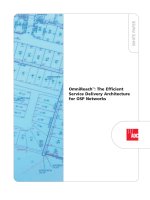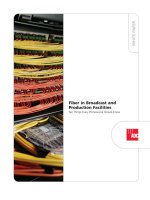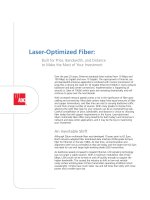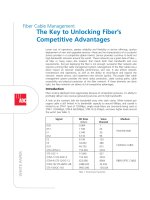Tài liệu ADC KRONE - Guide Book - FTTP - The Efficient Service Delivery Architecture for OSP network docx
Bạn đang xem bản rút gọn của tài liệu. Xem và tải ngay bản đầy đủ của tài liệu tại đây (782.49 KB, 8 trang )
OmniReach
™
: The Efficient
Service Delivery Architecture
for OSP Networks
WHITE PAPER
Current outside plant (OSP) networks, particularly those deploying fiber, were designed
primarily with transport and backhaul in mind – a means to carry telecommunications
traffic on and off a larger transport system and usually over long distances. There was
little demand for actual service delivery to multiple end users, although an occasional
large business customer might require as much as an OC-3 or OC-48, Megabit Ethernet,
Fibre Channel, or other connection for day-to-day business operations.
Times have changed. Today, fiber is being deployed much deeper into the network, both
for business and residential consumers. The demand for high-speed voice, data, and video
services is escalating, and new distribution architectures must be added to OSP networks
to reach these customers. However, serving the small business and residential customer
requires architecture that can efficiently connect millions of users onto a local network.
Fiber-to-the-premises (FTTP) systems, based on passive optical network (PON) architecture,
provide the access piece to traditional OSP networks for bringing multiple services to
multiple business and residential customers.
PON – Catalyst for the FTTP Revolution
PON architectures are optical transmission systems designed to carry transmission signals
via fiber-optic cable from the central office (CO) directly to the end user – such as a
business, multi-tenant unit, or individual home. The network is passive because once the
signal leaves the central office, there are no powered electronics or optical components
involved. The signal is guided through the fiber to the end user by connecting and
splitting components, traveling up to, and in some cases, exceeding 20 km. At the end
user, the optical signal is converted back to electrical by an optical network terminal (ONT)
for use as telephony, Internet, or video.
OmniReach
™
: The Efficient Service Delivery Architecture
for OSP Networks
Feeder OSP Cable
From C/O
Central Office
Splice Case
Splice Case
Fiber
Distribution
Terminal
Drop
Cable
Drop
Cable
Fiber Access
Terminal
Distribution
Cable
Distribution
Cable
The Efficient Service Delivery Architecture for OSP Networks
Page 2
Information from the end user flows from the premises
back through the PON to the CO, using wavelength
division multiplexing (WDM). WDM enables different
wavelengths of light to be transmitted over a single fiber
in either direction. PON offers distinct advantages over
competing technologies because of its passive nature,
such as eliminating the need for any electrical power
unit. PON can function in the OSP under environmental
extremes, and its low maintenance and data independent
nature provides significant operational and upgrade cost
benefits to telecom providers.
A New Way of Thinking
With the introduction of FTTP architectures comes a new
set of issues and concerns to challenge networking
engineers. Large-scale FTTP networks require providers to
ask some tough questions about their traditional
methods of building, operating, and maintaining the OSP
network. Which overall design, particularly in terms of
which splitter approach to use, will be most cost-efficient
in a particular deployment scenario? Which will provide
the necessary flexibility – connectorization or splicing?
What components will provide the best performance?
How many access points will be needed for testing and
maintaining the system? How much training will
technicians need to ensure proper cable management
and slack storage? How does one deal with the new
implications posed by FTTP for the central office?
There are various answers for every decision. Choosing
the wrong answer can be the difference between an
efficient, revenue-generating network versus one that
will constantly require upgrades and overhauls as
demand and technology moves forward. ADC has
introduced craft-friendly access networks based on many
years of experience in addressing these and other
concerns posed by customers.
PON architectures require key decisions that depend
heavily on service area considerations, such as physical
proximity of end users and service take rates, to
determine what components are optimal and their
placement within the network. This paper will address
pros and cons, as well as solutions, to the challenges
faced by today’s forward-thinking service providers who
view FTTP as the next major marketplace for increased
revenues through superior service offerings.
Higher OLT Efficiency is a ‘Splitter’
Decision
There are two main approaches to FTTP optical splitters:
centralized and cascaded. Through research, statistical
data, and lessons learned, ADC has concluded that in
most cases, a 1x32 centralized splitter configuration
provides distinct advantages over a cascaded splitter
approach. The first reason for choosing a centralized
splitter approach is to obtain the highest possible
efficiency of the optical line terminal (OLT) cards. Each
PON card services a maximum of 32 end users, providing
an optical signal to each ONT at the premises.
A cascaded approach, however, requires dedication, or
“hard-wiring,” of fibers to certain locations, leaving a
real possibility of stranded connections whenever take
rates are not high – making additional (and expensive)
PON cards necessary. A centralized approach makes use
of all 32 connections on each PON card, resulting in
maximum efficiency and the need for fewer cards.
Additionally, the 1x32 centralized splitter provides for a
modular build that enables budgeting costs with revenue
growth.
Testing also becomes a challenge with a cascaded
approach. To use an optical time-domain reflectometer
(OTDR) for testing multiple splitters, each fiber must be
characterized with certain identifiable traits for
recognition by the OTDR. From a centralized point, it is
also difficult to see through an array of splitters down
individual fiber lengths. In a centralized system, all
troubleshooting is done from a single, centralized point.
A centralized splitter also provides better overall loss
measurements compared to the cascaded approach.
One argument for a cascaded splitter approach has
traditionally been that it makes more sense in a very high
take rate situation. Cable costs may be less since a 12-
fiber cable used in the cascaded approach may substitute
for the 72-fiber cable used in the centralized architecture.
However, since the price differential is probably not
excessive (glass is fairly inexpensive today) and holes are
being dug to bury the cable anyway, why not put the
higher fiber count in case future upgrades or additions
become possible? The economies of gaining simpler
testing ability will almost always outweigh any cost
savings realized in using smaller fiber counts.
The Efficient Service Delivery Architecture for OSP Networks
Page 3
1x4 or 1x8
Splitter
Central Office
OSP
Enclosure
1x4 or 1x8 Splitters
1x4 or 1x8 Splitters
Central Office
up to
1xN Splitter
(N up to 32)
FTTP Cascaded Optical Splitter Network Diagram
FTTP Centralized Optical Splitter Network Architecture
The Efficient Service Delivery Architecture for OSP Networks
Page 4
Connectors vs. Splicing – A Common
Sense Approach Reaps Big Benefits
Another major consideration in building a cost efficient,
flexible, distribution network is deciding when to splice
and when to use connectors. A simple rule of thumb
would be to splice connections that will remain
permanent, and use connectors wherever a need for
access may occur. Still, there are other factors to consider.
Splicing may be preferable for distribution cables to
achieve reasonable distances that can be easily and
efficiently managed. Connectors, on the other hand,
provide easy access for testing and troubleshooting. They
also provide the network with considerably more
flexibility in terms of making adjustments or changes
during services provisioning.
Traditional OSP networks used splicing exclusively as a
means of interconnecting cables. However, where a
distribution network is involved, splicing could be a very
expensive and time-consuming operation. Since
distribution networks require numerous connections for
quickly turning up services to thousands of homes and
businesses, connectors offer more flexibility and less
personnel training to accomplish. The number of
technicians and equipment required for multiple splicing
operations should be considered.
Finally, connectors enable easier access for
troubleshooting and maintenance operations. They
provide access at multiple points along the network and
are certainly simpler than cutting into the cable to
perform these same operations. The mythical “seamless”
network may have appeared as a good solution for
transport and backhaul operations, but with an access
network, the ability to easily test and monitor is essential.
Without seams provided by connectors, there is no
access or ability to physically restore a network outside of
cutting into the optical cable.
The risk of inadvertent failure also increases when cutting
and splicing cables, leaving a possibility of service
interruption or failure to other customers while
troubleshooting a problem in another area of the
network. To most service providers, this is an
unacceptable risk.
•
•
•
•
•
•
•
•
•
•
•
•
•
•
•
•
•
•
•
•
Foreword Path
1xN Sp
litter
Bulkhead
Plate
Drop Cable
OSP
Cable
From C/O
Return Path
1xN Splitter
Factory Terminated
Connectors
Factory Terminated
Conne
ctors
Bulkhead
Plate
Splice
Enclosure
Bulkhead Plate
Cross Connect
Patch
cords
Enclosure
FTTP Splitter Connector Access (Input and Output Connected)









